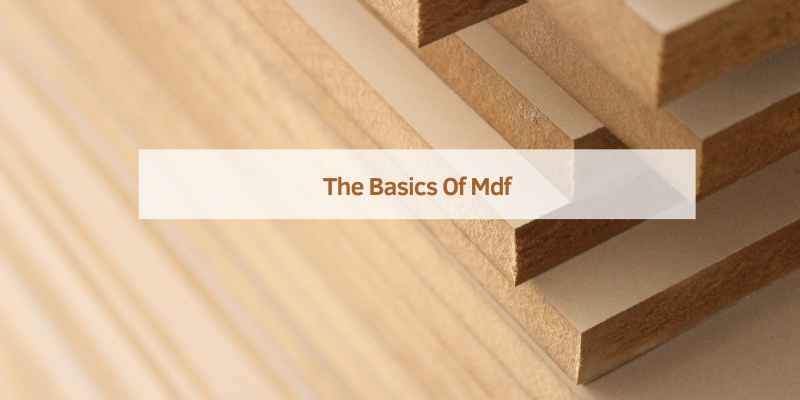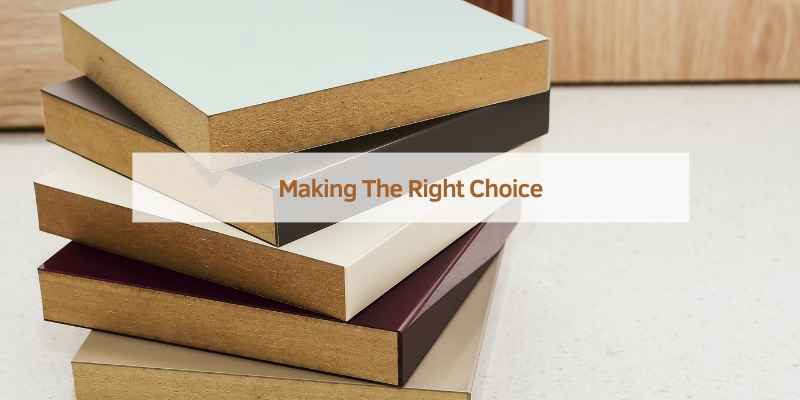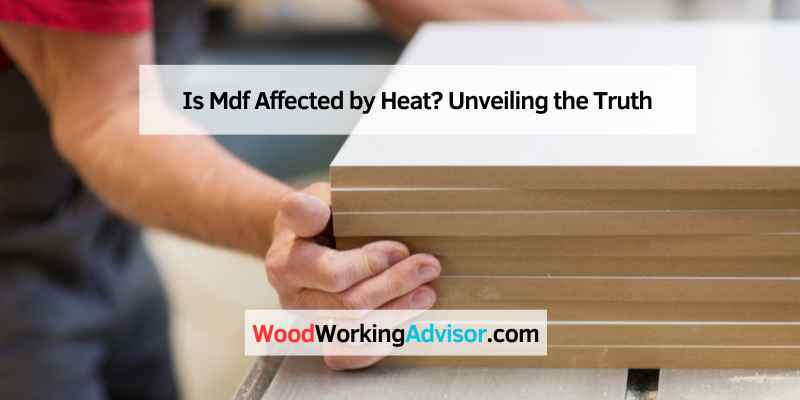MDF is affected by heat and changes in weather, especially humidity. The material is prone to moisture absorption, which can cause it to expand, warp or even break down over time.
In high humidity environments, MDF can absorb moisture from the air, leading to potential damage. Similarly, in very dry conditions, MDF can shrink and crack. To protect MDF from the effects of weather, it is recommended to keep it in a controlled environment with stable humidity levels.
Additionally, sealing MDF with a primer and paint or a clear sealant can help to protect it from moisture and humidity. It is important to note that MDF is not fire-resistant and can be a potential fire hazard if exposed to high heat or flames.
The Basics Of Mdf
MDF is affected by heat as it can lead to warping and distortion due to the expansion and contraction of its fibers with changes in humidity. High temperatures can cause MDF boards to become prone to warping, making it important to keep them in a controlled environment with stable humidity levels to prevent damage.
Composition And Manufacture
MDF is made by breaking down hardwood or softwood residuals into wood fibers, combining with wax and a resin binder, and forming into panels under high temperature and pressure.
Common Uses And Advantages
- Versatile Material: MDF is commonly used for furniture, cabinets, shelving, and decorative molding.
- Smooth Surface: Provides a uniform and smooth surface for painting and finishing.
- Cost-Effective: More affordable than solid wood alternatives.
- Stability: Resistant to warping and shrinking under normal conditions.

Mdf’s Battle With Heat
MDF can be affected by heat, leading to warping and distortion as the fibers expand and contract. It is susceptible to moisture absorption, causing swelling and potential damage. To protect MDF from the effects of weather, it’s best to keep it in a controlled environment with stable humidity levels and avoid extreme temperature fluctuations.
Heat’s Impact On Mdf
MDF, or Medium Density Fiberboard, is a popular material in the construction industry due to its affordable cost and versatility. However, despite its popularity, MDF’s battle with heat is a well-known issue. MDF is susceptible to warping, distortion, and even cracking when exposed to high temperatures. This is because the fibers in the boards expand and contract with changes in humidity, which causes them to absorb and retain moisture from the air.
Warping And Distortion Risks
When exposed to heat, MDF can warp and distort, leading to structural damage and even making it unusable. This is a significant concern in areas with high temperatures or in buildings without adequate climate control. MDF can also be damaged by extreme temperature fluctuations, leading to cracks and other forms of damage. To mitigate these risks, it is recommended to keep MDF in a controlled environment with stable humidity levels, away from areas with high humidity or extreme temperatures.
Protecting Mdf From Heat
There are several steps that can be taken to protect MDF from heat damage. Sealing the MDF with a primer and paint or a clear sealant can help to protect it from moisture and humidity. Additionally, using MDF with a higher density can make it more resistant to heat. It is also recommended to avoid exposing MDF to direct sunlight or placing it near heat sources, such as radiators or stoves. By taking these precautions, MDF can be protected from heat damage, ensuring its longevity and durability.
In conclusion, MDF’s battle with heat is a well-known issue that can lead to warping, distortion, and cracking. However, by taking the appropriate precautions, such as sealing the MDF and avoiding exposure to extreme temperatures, MDF can be protected from heat damage, ensuring its longevity and usability.
Moisture: The Hidden Culprit
When it comes to the impact of heat on MDF (Medium Density Fiberboard), moisture is the hidden culprit that can cause significant damage. MDF is a composite wood product made by breaking down hardwood or softwood residuals into wood fibers, combining them with wax and a resin binder, and forming them into panels under high temperature and pressure. While MDF is known for its versatility and affordability, it is also susceptible to moisture absorption, which can lead to various problems.
Moisture Absorption And Expansion
MDF has a tendency to absorb moisture from the surrounding environment. In high humidity conditions, such as in bathrooms or damp basements, MDF can absorb moisture from the air, causing it to swell and potentially warp. This expansion can lead to structural instability and compromise the integrity of the material.
On the other hand, in very dry conditions, MDF can shrink and crack, further reducing its durability. These changes in dimensions can result in a distorted and weakened MDF frame, making it unsuitable for its intended purpose.
Preventing Moisture Damage
To protect MDF from the damaging effects of moisture, it is crucial to take preventive measures. Here are some strategies to consider:
- Avoid placing MDF frames in areas with high humidity or extreme temperature fluctuations.
- Keep MDF in a controlled environment with stable humidity levels.
- Seal the MDF with a primer and paint or a clear sealant to provide an additional barrier against moisture.
- Ensure proper ventilation in the room where MDF is installed to minimize the accumulation of moisture.
- Regularly inspect MDF frames for any signs of moisture damage and take prompt action to address them.
By following these preventive measures, you can significantly extend the lifespan of your MDF frames and maintain their structural integrity.
In conclusion, moisture absorption and expansion are key factors to consider when it comes to the impact of heat on MDF. By understanding the hidden culprit of moisture and taking preventive measures, you can ensure that your MDF frames remain in optimal condition and withstand the test of time.
Heat Resistance Of Mdf
MDF, or Medium Density Fiberboard, is a popular engineered wood product made by breaking down hardwood or softwood residuals into wood fibers, which are then combined with wax and a resin binder. The panels are formed by applying high temperature and pressure, resulting in a versatile material used in various applications. When it comes to heat resistance, MDF has specific characteristics that need to be considered.
Comparing Mdf To Solid Wood
While solid wood can be affected by heat, MDF is known for its better resistance to high temperatures. The engineered nature of MDF makes it less prone to warping, swelling, or distortion compared to solid wood when exposed to heat.
Flame Retardant Mdf Solutions
For applications where fire safety is a concern, using flame retardant MDF can be a viable solution. Flame retardant additives are incorporated into the manufacturing process of MDF to enhance its resistance to fire and high temperatures, making it a suitable choice for environments where fire safety is paramount.
Temperature Tolerance Of Mdf
Medium Density Fiberboard (MDF) is a versatile and widely used material in various applications. Understanding its temperature tolerance is crucial for ensuring its longevity and performance.
Safe Operating Temperatures
MDF has a safe operating temperature range of 70°F to 90°F. Operating within this range ensures stability and minimizes the risk of warping or distortion due to temperature fluctuations. It is essential to maintain a consistent temperature environment to preserve the integrity of MDF.
At What Temperature Does Mdf Burn?
MDF starts to burn at approximately 425°F. Exposing MDF to high temperatures beyond this point can lead to combustion, emitting harmful gases and causing structural damage. It is imperative to protect MDF from direct exposure to heat sources to prevent combustion and maintain its structural integrity.
Protective Measures For Mdf
Medium Density Fiberboard (MDF) is vulnerable to heat and can be affected by changes in weather, particularly humidity. The susceptibility of MDF to moisture absorption can lead to swelling, warping, or even breakdown over time, while very dry conditions can cause shrinkage and cracking. To safeguard MDF from the detrimental effects of heat and humidity, protective measures should be taken.
Sealing And Priming
Sealing and priming MDF is essential to protect it from moisture absorption and heat-related damage. Applying a high-quality primer and paint, or a clear sealant, creates a protective barrier that helps to mitigate the impact of changes in humidity and temperature. Proper sealing and priming also enhance the durability and longevity of MDF, making it less susceptible to warping, swelling, or cracking.
Environment Control
Controlling the environment in which MDF is placed is crucial for its preservation. Avoiding high humidity areas such as bathrooms or damp basements, as well as locations with extreme temperature fluctuations, can significantly reduce the risk of heat-related damage to MDF. Maintaining stable humidity levels and temperature within the recommended range is vital for the long-term integrity of MDF.
Mdf In High Humidity And Dry Conditions
MDF is a versatile material used in a variety of applications, but it can be affected by environmental conditions such as high humidity and dryness. Understanding the effects of these conditions on MDF is crucial for maintaining its quality and durability.
Effects Of High Humidity
High humidity can have a detrimental impact on MDF, causing it to absorb moisture from the air and swell. This can lead to warping, distortion, and potential damage to the material. In addition, prolonged exposure to high humidity can compromise the structural integrity of MDF, making it less suitable for certain applications.
Handling Dry Conditions
On the other hand, dry conditions can also pose challenges for MDF. In low humidity environments, MDF is susceptible to shrinking and cracking, which can affect its overall stability and appearance. Proper handling and storage are essential to prevent these issues and maintain the quality of MDF.
Making The Right Choice
When it comes to choosing the right material for furniture and woodworking projects, it’s essential to consider the impact of heat on the materials. One common material that is often used in furniture manufacturing is Medium Density Fiberboard (MDF). Understanding how MDF is affected by heat is crucial in making informed decisions when it comes to selecting the appropriate material for your projects.
Mdf Vs. Solid Wood Furniture
When comparing MDF to solid wood furniture, it’s important to consider how each material responds to heat. While solid wood may be more resistant to heat, MDF has its own set of advantages, especially in terms of cost-effectiveness and versatility. Solid wood furniture may be more susceptible to warping and cracking under extreme heat, whereas MDF is engineered to be more stable in high-temperature environments.
When To Use Mdf
Choosing MDF for your projects can be a practical decision, especially when you need a material that is less prone to warping and distortion due to heat. MDF is an ideal choice for indoor furniture and cabinetry, where temperature and humidity levels can fluctuate. It’s essential to keep in mind that MDF should be used in environments with controlled humidity levels to prevent potential damage caused by heat and moisture absorption.

Frequently Asked Questions
Does Heat Damage Mdf?
High temperatures can cause warping and distortion in MDF boards due to moisture absorption and fiber expansion.
Is Mdf Resistant To Heat?
MDF (Medium Density Fiberboard) is not resistant to heat. It can be affected by high temperatures, causing warping, distortion, and potential damage. It is recommended to keep MDF in a controlled environment with stable humidity levels to protect it from heat-related issues.
What Temperature Is Mdf Safe?
MDF boards can become prone to warping and distortion at high temperatures. The fibers in the boards expand and contract with changes in humidity, as the boards can absorb and retain moisture from the air. It is recommended to keep MDF in a controlled environment with stable humidity levels.
At What Temperature Does Mdf Burn?
MDF boards can warp and distort at high temperatures due to moisture absorption and fiber expansion.
Conclusion
It is crucial to protect MDF frames from temperature fluctuations to prevent damage. High humidity can cause swelling, warping, and cracking, while extreme dryness can lead to shrinkage. Keeping MDF in stable, controlled environments and sealing it can help maintain its integrity over time.

